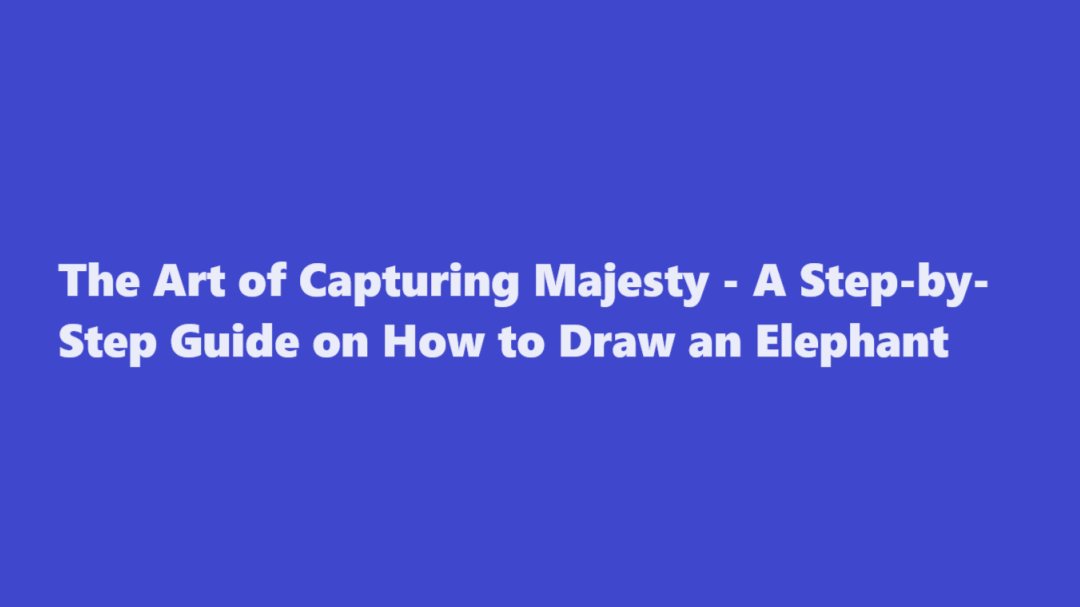The Art of Capturing Majesty – A Step-by-Step Guide on How to Draw an Elephant


Introduction
Drawing is a beautiful form of expression that allows us to capture the essence and beauty of the world around us. One of the most captivating subjects to draw is the majestic elephant, a symbol of strength, wisdom, and grace. In this step-by-step guide, we will explore the techniques and tips needed to create a stunning elephant drawing. Whether you’re a novice artist or an experienced one, with patience and practice, you can bring this remarkable creature to life on your canvas.
Materials You Will Need
Before we dive into the drawing process, gather the essential materials to make your elephant drawing a success. You will need
1. Drawing paper or a sketchbook
2. Pencils of varying hardness (2H, HB, 2B, 4B)
3. Erasers (both kneaded and vinyl erasers)
4. Blending tools (tortillons or blending stumps)
5. Reference images of elephants
6. A comfortable, well-lit workspace
Step 1 – Start with Basic Shapes
Begin by lightly sketching the basic shapes of your elephant. The body can be represented as an oval, and the head as a larger circle attached to it. The trunk can be drawn as a curved, elongated shape. Remember, these initial shapes are just guidelines, and you’ll refine them as you progress.
Step 2 – Outline the Elephant’s Body
With the basic shapes in place, start outlining the elephant’s body more precisely. Pay attention to the curves and proportions, ensuring that the legs and ears are appropriately sized. Elephants come in various species and sizes, so your reference image will be invaluable in creating an accurate representation. Use a softer pencil (2B or 4B) to create a darker outline, and erase any unnecessary guidelines.
Step 3 – Add Details to the Face
The elephant’s face is the most captivating part of the drawing. Focus on the eyes, ears, and trunk. Elephants have expressive eyes, so make sure to capture their depth and shape. The ears are typically large and irregularly shaped, and the trunk is flexible, allowing for a wide range of poses. Use different pencil grades to create varying shades and textures, emphasizing wrinkles and textures on the trunk and ears.
Step 4- Refine the Body
Now, go back to the body and add more details, like wrinkles, folds in the skin, and muscle definition. Elephants have thick, wrinkled skin, especially around their neck and back. Use your reference image to guide you in depicting these natural features. Lightly shade areas that should be darker, and use an eraser to create highlights and accents.
Step 5- Work on the Legs
Elephant legs are sturdy and powerful. Sketch them with care, making sure they are in proportion to the body. Add wrinkles and creases to indicate the joints and muscles. Pay attention to the positioning of the legs, as elephants can stand in various ways, with one leg raised or lowered. This will add a sense of motion and life to your drawing.
Step 6- Create Background and Shadows
Consider adding a background to your drawing to provide context and depth. Whether it’s a natural habitat, a savanna, or an artistic backdrop, it can enhance the overall composition. To make your elephant appear three-dimensional, add shadows and shading. Identify the primary light source in your reference image, and shade the areas that would be in shadow. Gradually build up the darkness, using a blending tool to smooth transitions between light and shadow.
Step 7 – Final Touches and Details
Before completing your elephant drawing, take a moment to refine any remaining details. Adjust the shading and highlights, paying close attention to the texture of the skin. Strengthen the contours and add any missing features or accents. Step back, assess your work, and make any necessary adjustments to ensure the drawing accurately captures the essence of this magnificent creature.
FREQUENTLY ASKED QUESTIONS
What are the 7 colors of the rainbow in order?
The colours of the rainbow are: Red, orange, yellow, green, blue, indigo, violet.
Is indigo blue or purple?
Indigo is a rich color between blue and violet on the visible spectrum, it’s a dark purplish blue. Dark denim is indigo as is Indigo dye. It’s a cool, deep color and also a natural one. True Indigo dye is extracted from tropical plants as a fermented leaf solution and mixed with lye, pressed into cakes and powdered.
Conclusion
Drawing an elephant is a challenging but rewarding endeavor. With patience, practice, and attention to detail, you can create a stunning representation of this majestic animal. Remember that art is about self-expression and interpretation, so feel free to add your unique touches to make your elephant drawing a work of art that truly speaks to your creative vision.
Read Also : Mastering The King’s Gambit – Unleash Your Inner Chess Grandmaster
Recent Posts
A Step-by-Step Guide to Turning Off Your PS4
Introduction The PlayStation 4 (PS4) has been a gaming staple for millions of gamers worldwide…
How to Get a Receipt from Amazon – A Step-By-Step Guide
Amazon, the world's largest online retailer, offers a convenient and efficient way to shop for…
How to Leave a Group Chat on iPhone – A Step-by-Step Guide
Introduction Group chats are a fantastic way to stay connected with friends, family, or colleagues,…
A Comprehensive Guide on How to Pack a Bowl
Introduction Packing a bowl is a skill that many individuals enjoy mastering, whether for medicinal…
How to Properly Turn Off a Tesla Electric Vehicle
Introduction Tesla electric vehicles (EVs) have revolutionised the automotive industry with their cutting-edge technology and…
Mastering The King’s Gambit – Unleash Your Inner Chess Grandmaster
Introduction The King's Gambit, one of the oldest and most aggressive chess openings, has fascinated…



